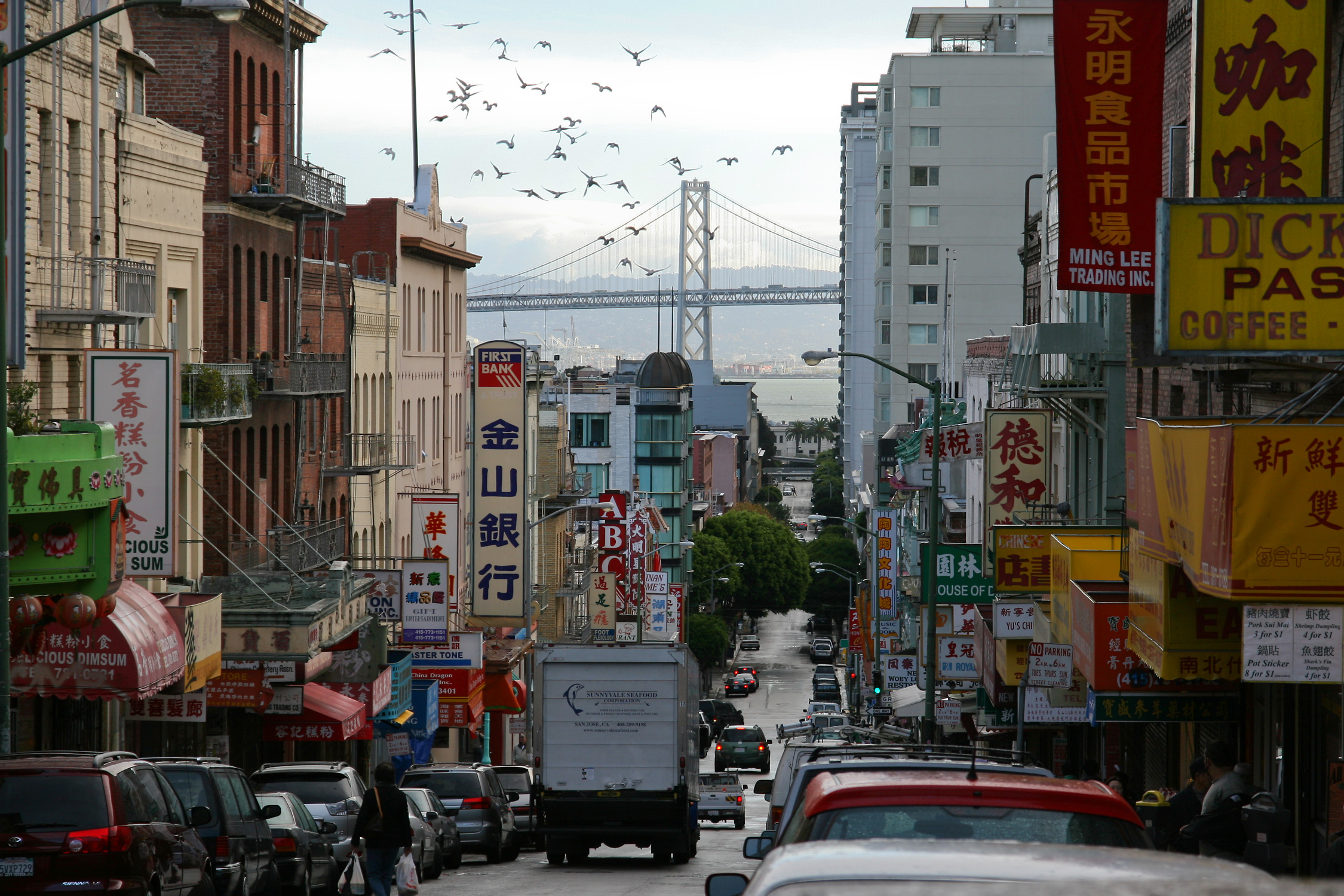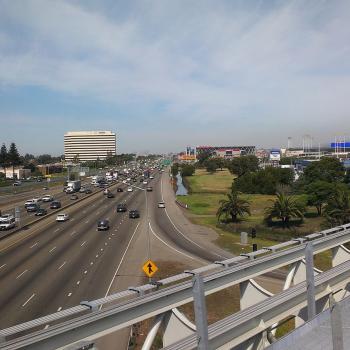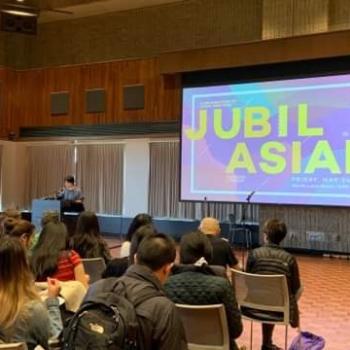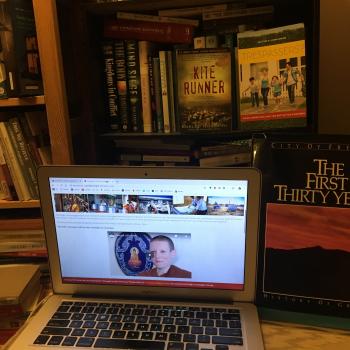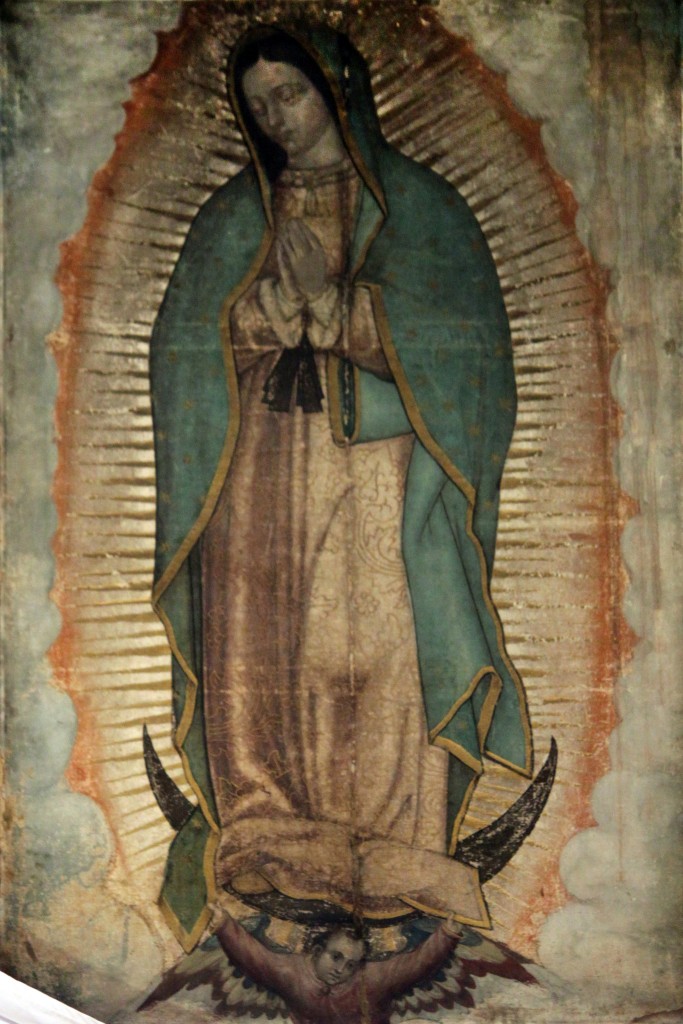
Despite my efforts to get back to the evangelical material with #TPCIU (though it is not only ‘evangelical’; stay tuned), it seems unavoidable that on a week with two Marian feasts, I am now blogging about controversy about things Roman Catholic. I put up a less-noticed post on about why the Immaculate Conception should make you think of Asian Americans. Perhaps this second post will give that piece a second read. That is to say, this Feast Day of Our Lady of Guadalupe is stirring up some controversy about what she means for the Americas. Toward the end of this post, I’ll explain a bit more of why someone interested in contested evangelicalisms should also be interested in contested Catholicisms.
The light controversy seems to be revolving around what can and can’t be appropriately appropriated from the Roman Catholic repository of stuff to appropriate. In Catholic news, for example, Hans Küng has gone on the record yet again on Der Spiegel to talk about his right to die; the question is whether he can appropriate that right into Catholic theology. So too, Asian American theologian Nami Kim has posted a feminist query to Pope Francis about his decision to keep the door on women’s ordination closed; the question is whether it’s feminism or patriarchy that’s the real appropriation there.
But in all honesty, the conversation, at least in my circles, has revolved around whether symbols of the Americas, particularly the Virgin of Guadalupe, can be appropriated for a variety of political and theological purposes.
It started like this. Because I have been blogging and posting on how the private consensus is unraveling, some have complained that my posts lack a sort of charity toward evangelical celebrities. I would contest this in a variety of ways, but on this Feast of Our Lady of Guadalupe, I decided to launch a provocation on social media that stated this: perhaps evangelical accounts of charity may have shortchanged the word ‘charity’ because they lack a Marian quality. Following another provocative post on A Christian Thing, I asked whether the ‘evangelical’ dimensions of the Virgin might help evangelicals understand that a dynamic of charity is also to be as prophetic as the Marian apparitions’ challenges to the existing powers of their days.
The premises of my question were challenged by some who felt that my appropriation of the Lady of Guadalupe decontextualized her from Mexican nationalism. They asked questions like: what does the Patroness of the Americas stand for? Does it matter if Juan Diego’s tilma is a fake? If she can be appropriated, then can other American religion symbols, like the Book of Mormon? Per Andy Smith’s Native Americans and the Christian Right, how much rearticulation is appropriate?
For Catholic support, I’ll appeal to Artur Rosman’s continuing theme of ‘Rabelaisian Catholicism’ on Cosmos the in Lost. Apparently, I served as some sort of inspiration for this theme, and I must return the favour by invoking him.
What Rosman argues is that there is no ‘pure form of Catholicism,’ if you will. Appealing to François Rabelais’s love for the grotesque, Rosman suggests that, pardon the French, ‘even assholes can do the good,’ mirroring theologian James Alison’s comments that ‘that one of the first things I had to learn about being a Catholic – bizarrely – was how to sin.’ Accordingly, Rosman has recently argued that the notion that there is a pure form of Catholicism that can be separated from the ‘pollution’ of any culture is nonsensical, be it Hellenic philosophy, pagan practices, or the orientalized Polish nationalism whose record Rosman consistently tries to set straight. In this way, Rosman builds a bridge from official Catholic theologies to the supposedly revolutionary work of ‘lived religion’ theorists like Robert Orsi and Meredith McGuire by showing that the distance between the ‘official’ and ‘unofficial’ may not be as far as what things may seem. In fact, the articulation of a ‘pure Catholicism’ is up for contestation at any time within official Catholic theology, and as Peter Phan and Jonathan Tan show through popular Asian Catholic practices, these challenges are happening in practice all the time.
This ‘lived religion’ quality of ‘official Catholic teaching’ suggests controversially that the Lady of Guadalupe may be a more unstable symbol that is open to a range of interpretations. Just as the Book of Mormon has become what Harold Bloom calls the text for the ‘quintissential American religion,’ Our Lady of Guadalupe has a range of meanings that is not only located within Mexican nationalist politics. For Archbishop Jose Gomez, for example, the Patroness of the Americas can be deployed to advance immigration reform in the United States (and to rewrite American history from the view of Spanish missions) while staying within a conservative Catholic account of Catholic social teaching that sees Mary as mother of the unborn and the mother of the New Evangelization as well. So too, the Lady of Guadalupe appears on prayer cards championing religious freedom. Still also, the Virgin of Guadalupe may serve as a rallying cry for Chicana/o politics. And then again, John Paul II preached a message of social justice and pacifist politics at the Basilica of Our Lady of Guadalupe in 1999.
Yet each of these themes asks us to consider the place of the Virgin of Guadalupe in contesting the meaning of the Americas. Whether immigration reform, religious freedom, the rights of the unborn as a contested minority right, social justice, pacifist politics in a geopolitically violent world, or the land claims of Chicana/o and indigenous activists, these are distinctly American themes in the broadest sense. Following the provocations of scholars like Manuel Vàsquez and Jennifer Hughes to take an ‘Americas’ perspective on religion, these multifaceted themes suggest that the term ‘American religion’ should be opened up to include all of the Americas, and that one way to focus that sort of interpretation would be to examine the place of the Virgin of Guadalupe in contesting how the Americas should be conceptualized. Indeed, as Stanley Hauerwas once noted, the ‘importance of being Catholic’ is that Catholicism in the Americas historically posed challenges to the constitution of the American nation-state, and it is a fairly recent development (pace Will Herberg’s Protestant-Catholic-Jew) that Catholicism has itself become an American religion.
I confess that here my work will rely on those who will be able to do this sort of important work. My own work focuses on religion in Asian American publics, generating my thoughts on publics in the Americas from a narrower field of interests. Asian American publics may seem far irrelevant from the interests of Latina/o, Chicana/o, and indigenous scholars, as well as from Catholic studies and lived religion studies. So too, with the increasing interest in Asian American Christians as ‘evangelicals,’ one might wonder whether all this Catholic stuff is relevant.
Yet I have always been struck by how much the ‘trans-Pacific’ dimensions of Asian American studies often occludes the reality that geographically speaking, Latin America should be part of a Pacific conversation. So too, the notion of Asian American publics should include relations with other racialized populations.
It’s from that sideways angle from which my curiosity about the place of Virgin of Guadalupe stems, just like how my explorations into San Francisco’s Chinatown yielded a very surprising link to the promulgation of the Dogma of the Immaculate Conception. Catholics, it turns out, always seem to be in the background of Protestant studies and inquiries into the constitution of publics. When I was in Hong Kong, I found solid solidarities being formed between progressive Protestants and Catholics for human rights activities; while I was in Vancouver, I found that Cantonese Protestants and Catholics said that they seldom talked to each other (something the BBC also learned), but then there were points of political convenience when they did. I can never never get away from the Catholic stuff when I study religion among Asian Americans, Asian Canadians, and the Asia-Pacific because honest research always pulls me into these strange connections. That is to say, I’d like to learn more about things like the Virgin of Guadalupe because I’m starting to see that she’s a figure constantly deployed in the contestation of the Americas, and if that’s so, then she’s important to my work on Asian American and Asian Canadian publics.
In short, Catholic controversy is not as far afield from American studies–and even Asian American studies–as one might think. (I think the Augusto Espiritu and the late Steffi San Buenaventura would agree. Also, keep your eyes peeled for the fascinating work of Thien-Huong Ninh.)
In turn, returning to my original question about evangelical ‘charity,’ I wonder whether the Lady of Guadalupe might in turn be one interesting symbol to which to turn for #TPCIU. This is an open question. While deployed for all sorts of nationalist and transnational politics, she certainly destabilizes the notion that that any group in the Americas is a self-contained group with no relation to the other. After all, here’s what Pope Francis says about her:
When Our Lady appeared to Saint Juan Diego, her face was that of a woman of mixed blood, a mestiza, and her garments bore many symbols of the native culture. Like Jesus, Mary is close to all her sons and daughters; as a concerned mother, she accompanies them on their way through life. She shares all the joys and hopes, the sorrows and troubles of God’s People, which is made up of men and women of every race and nation.
When the image of the Virgin appeared on the tilma of Juan Diego, it was the prophecy of an embrace: Mary’s embrace of all the peoples of the vast expanses of America – the peoples who already lived there, and those who were yet to come. Mary’s embrace showed what America – North and South – is called to be: a land where different peoples come together; a land prepared to accept human life at every stage, from the mother’s womb to old age; a land which welcomes immigrants, and the poor and the marginalized, in every age. A land of generosity.
Can that be seen as a Catholic challenge to the private consensus? Is there a private consensus within American Catholicism that is unraveling parallel to the evangelical one? Can it be said that a ‘Catholic private consensus’ was created when Catholicism became an ‘American religion’? These are open questions. I, for one, would be interested in digging deeper.
UPDATE: The friend with whom I was having the friendly and collegial argument on social media suggested that I missed one of his central points, which I also think is important after further explanation. He wanted me to see that the Virgin of Guadalupe was first an ‘interwhite’ symbol that was only tactically indigenous and that the diversity of Mexico comprises a diverse range of Europes that are embedded in the landscape. It was then transformed into a pan-Mexican nationalist symbol. These are important points that get at the instability and contested nature of the Lady of Guadalupe in the contestation of the Americas. I, for one, appreciate his careful reading and critically collegial conversation.
UPDATE #2: We thank our friends who push us in directions I’ve never thought of going. My friends and I are now constructing a Catholic studies reading list and have encouraged me to look into the debate about David Tracy’s Analogical Imagination. This in turn is forcing me to read Aquinas, of all people. I suppose that serves me right for wanting to look into Catholic controversy. Those with further recommendations can put them down publicly on this blog’s Facebook page and Twitter handle.

